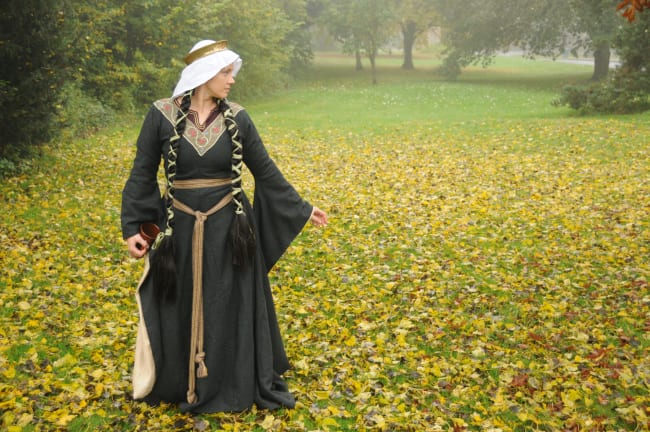 Creepy
Creepy  Creepy
Creepy  Movies and TV
Movies and TV 10 Movies That Get Elite Jobs Right, According to Experts
 Weird Stuff
Weird Stuff 10 Times Real Laws Were Based on Bizarre Hypotheticals
 Animals
Animals 10 Inspiring Tales of Horses Being Human
 Mysteries
Mysteries Top 10 Haunting Facts About the Ghost Ship MV Alta
 History
History 10 Surprising Stories About the Texas Rangers
 Humans
Humans 10 Philosophers Who Were Driven Mad by Their Own Theories
 Miscellaneous
Miscellaneous 10 Video-Game-Worthy Weapons and Armors from History
 Weird Stuff
Weird Stuff 10 Psychics Who Accurately Predicted Wartime Events
 The Arts
The Arts 10 Pieces of Art Inspired by a Broken Heart
 Creepy
Creepy 10 Death Superstitions That Will Give You the Creeps
 Movies and TV
Movies and TV 10 Movies That Get Elite Jobs Right, According to Experts
 Weird Stuff
Weird Stuff 10 Times Real Laws Were Based on Bizarre Hypotheticals
Who's Behind Listverse?

Jamie Frater
Head Editor
Jamie founded Listverse due to an insatiable desire to share fascinating, obscure, and bizarre facts. He has been a guest speaker on numerous national radio and television stations and is a five time published author.
More About Us Animals
Animals 10 Inspiring Tales of Horses Being Human
 Mysteries
Mysteries Top 10 Haunting Facts About the Ghost Ship MV Alta
 History
History 10 Surprising Stories About the Texas Rangers
 Humans
Humans 10 Philosophers Who Were Driven Mad by Their Own Theories
 Miscellaneous
Miscellaneous 10 Video-Game-Worthy Weapons and Armors from History
 Weird Stuff
Weird Stuff 10 Psychics Who Accurately Predicted Wartime Events
 The Arts
The Arts 10 Pieces of Art Inspired by a Broken Heart
Top 10 Bizarre Fashion Trends In History
Strange trends in fashion seem like they’ve always been around. From paper dresses to platform crocs, many fashion trends have left people wondering, ‘What were they thinking’? From showing off one’s status to hiding illness are just a couple of reasons for some strange trends throughout history. This list covers 10 of the most bizarre fashion trends in history.
10 Fascinating Examples Of Disease Influencing Fashion
10 Bombast

If you’ve ever seen a person in a Elizabethan era painting, you’ve probably seen that person in puffy sleeves. These puffy sleeves are a result of stuffing, or bombast. And it wasn’t just the sleeves that were stuffed. Bellies, shoulders, and thighs would also be stuffed. Men were known to pad their calves as well.
Bombast was made from various materials, including cotton, wool, horsehair, and bran. The stuffing used was not light and soft like the large shoulder pads of the 1980s. Instead, the bombast was quite uncomfortable. The trend fell out of style in the mid 17th century.[1]
9 Bliauts

The bliaut was a long gown worn by wealthy men and women. The bliaut was one of the long garments worn worn during the late Middle Ages. This garment used a substantial amount of fabric, due to the high amount of drapes and pleats used in its construction.
Bliauts worn by women were tighter fitting in the upper arms, shoulders, and torso. However, the sleeves were extremely wide from the elbow down. The sleeves would extend all the way to the floor. While the gown for women would be floor length, men’s were shorter. A bliaut worn by a man would only reach his ankles. The male version was loose fitting, with the sleeves extending at the wrist instead.[2]
8 Chopines

Think 3 inch platform shoes are high? Those are nothing compared to this 16th Century shoe, or chopine. A chopine was a high-soled platform shoe that could be as tall as 20 inches.
Chopines, although impractical footwear, served the practical purpose of protecting the wearer’s feet from mud and dirt along the streets. Chopines were often worn by Spanish and Italian women to show off wealth and social importance. The higher the shoe, the higher the status. Women required longer dresses to balance proportions, which required more expensive dresses. Attendants would also be used by wearers to help maintain balance.
These high shoes may have had roots in Ancient Greece and Rome. There are early images in Greek mythology of Aphrodite wearing high platforms. After the Romans invaded Spain, they established a cork shoe-making industry.
Like many other fashions, the chopine was not to last. The 17th Century saw the beginning of the high heeled shoe, thus ending the trend.[3]
7 Crinolines

Crinoline was a popular fashion trend starting in the late 1840s. The crinoline was a petticoat made from horsehair. The crinoline was initially used to support and give shape to a woman’s dress. In order to achieve the large skirt look, the crinoline was wore worn with six starched petticoats. This was heavy and uncomfortable to the wearer.
The crinoline took different forms during its popularity. In the 1860s, it changed to a dome shape. By about 1865, it became nearly flat in front. By 1878, the crinoline was no longer popular.[4]
6 Codpieces

In the 1500s, men’s fashion had changed. Men wore a doublet, which was worn on the upper part of the body. Hose, which were made of two separate leggings, were attached to the doublet. Then a cloak was worn over the outfit. As doublets and cloaks shortened, a man’s private area would sometimes become accidentally exposed. In order to prevent this exposure, the codpiece was formed.
Codpieces started out as nothing more than a triangular shape of cloth. During the time when masculinity and chivalry were highly valued, the codpiece became longer and more ornate. As the trend progressed, codpieces would be made from silk velvet. The codpiece could even have jewels or embroidery on it.
During the late 16th Century, the codpiece began to fade. A new trend with men stuffing their clothes in the stomach area emerged, thus ending the reign of the codpiece.[5]
10 Of The Most Bizarre Modern Fashion Trends
5 Hobble Skirts

It seems strange that as the women’s suffrage movement was gaining momentum a new fashion trend would limit a woman’s movement. But in the 1910s, the hobble skirt was a hot fashion trend. The hobble skirt was a snug-fitting skirt that was cinched at the ankles. Where women used to walk and glide freely, they were reduced to only taking the tiniest of steps. Regardless of this limitation, women were more than happy to ditch their heavy petticoats which the hobble skirt replaced.
As the trend took hold, modifications to the skirt allowed women better mobility. Streetcars and trains reduced the height of their entrances to accommodate the skirt wearers. Hidden slits and pleats were added to allow longer strides.
Public figures denounced the trend and media were staunch opponents. Newspapers took every opportunity to publish stories about women with twisted ankles and broken legs caused by the hobble skirt.
The hobble skirt trend was short lived. By 1915, the First World War had begun and the hobble skirt didn’t seem to fit in with the times.[6]
4 Macaroni

Perhaps when you’ve heard the song Yankee Doodle, you were puzzled by this line: “stuck a feather in his cap and called it macaroni.” After all, who can’t tell the difference between a feather and a piece of pasta? However, in this song, macaroni was not a piece of pasta. Rather, it was a fashion trend.
In the 1760s, young British aristocrats were returning from a journey across Continental Europe, know as the Grand Tour. This was a standard trip intended to deepen cultural knowledge. These young aristocrats also came back with a new sense of fashion know as macaroni.
The macaroni trend was seen as a type of effeminate dress. It incorporated bold colors, while the traditional dress at the time favored darker clothing. Flashy shoes, tight pants, and short coats were also part of this trend. The trademark of this trend, however, was exaggerated wigs almost as tall as the wearer with tiny hats on top.
When the trend began, it was limited to only the upper class. By 1772, it had spread to all classes. As the trend spread, the femininity of the style was amplified. The term macaroni changed from a sophisticated British person to “a person who exceeded the ordinary bounds of fashion”. The public shaming and ridicule of the newer macaronis caused the end of the fashion trend.[7]
3 Mercury Hats

Hats in the 18th and 19th centuries were made of felt that came from beaver or rabbit hair. In this process, mercury, or more specifically, mercuric nitrate, was used to separate the fur from the animal pelt. This process was known as “carroting”.
While men who wore these hats were protected from mercury poisoning by the hat’s lining, the people who manufactured them weren’t so lucky. Ventilation was poor in the factories, causing larger amounts of mercury fumes to be inhaled. Hatters suffered a variety of ailments including “hatter’s shakes”, referring to tremors caused by mercury exposure. In Danbury, Connecticut, named “Hat City of the World”, this phenomenon was referred to as the “Danbury shakes”. Other ailments included paranoia, teeth loss, and hallucinations. While hatters attempted to achieve better working conditions, many just accepted it as part of life.
On December 1, 1941 Connecticut banned the use of mercury. The process of using of using hydrogen peroxide instead began to take place. However, the use of this poison did not completely end until the 1960s when men stopped wearing hats.[8]
2 Powdered Wigs

Ah, to have a long, luxurious head of hair. Who doesn’t want one? In the 17th and 18th centuries, this was not just a desire; it was a status symbol among European upper classes. Being bald meant being subject of great ridicule. To hide a person’s baldness, a powdered wig would be worn.
Of course, going bald is genetic. However, sometimes going bald was from more sinister reasons. During this time, syphilis rampant through Europe. One of the symptoms of syphilis was baldness. So the powdered wig would be worn to cover the wearer’s secret shame. Also around this time, people had a serious lack of personal hygiene. People believed bathing would open their pores, exposing them them to diseases. As a result of this belief, people rarely cleaned themselves. The lack of cleaning caused the body to smell. The wig was powdered in an attempt to hide a person’s smell. The powder would sometimes contain lavender or orange to further hide the stench.
French citizens stopped wearing the wigs during the Revolution. In Britain, a tax was levied a hair powder, leading to the end of the trend there. By the late 18th Century, wigs would be replaced by short, natural hair.[9]
1 Arsenic Dresses

Poison, poison everywhere. From candles to curtains, arsenic seemed to be in just about everything in the Victorian era. It was even in women’s clothing.
In 1814, a chemical company had invented a new green dye. Brighter and bolder than traditional dyes, it was dubbed “emerald green”. Women flocked to the color. With rooms being brighter thanks to the invention of gas lighting, women wanted to stand out in the crowd. The only problem was the reason for such a vibrant color was thanks to the arsenic in the dye. Due to the color’s popularity, it was not only in the dresses women wore, but also in gloves and shoes.
All of this exposure had effects on the women who wore such things. Arsenic exposure could cause problems such as rashes or hair loss. Exposure could also lead to severe symptoms such as kidney and liver failure. Manufacturers of these items were the most likely to die from its toxic effects.
Countries such as France and Germany banned the used of arsenic as a result of public concern. While countries such as Britain did not ban the substance, the rise of synthetic dyes helped phase out this toxic ingredient.[10]
Top 10 Pigments With Colorful Histories








